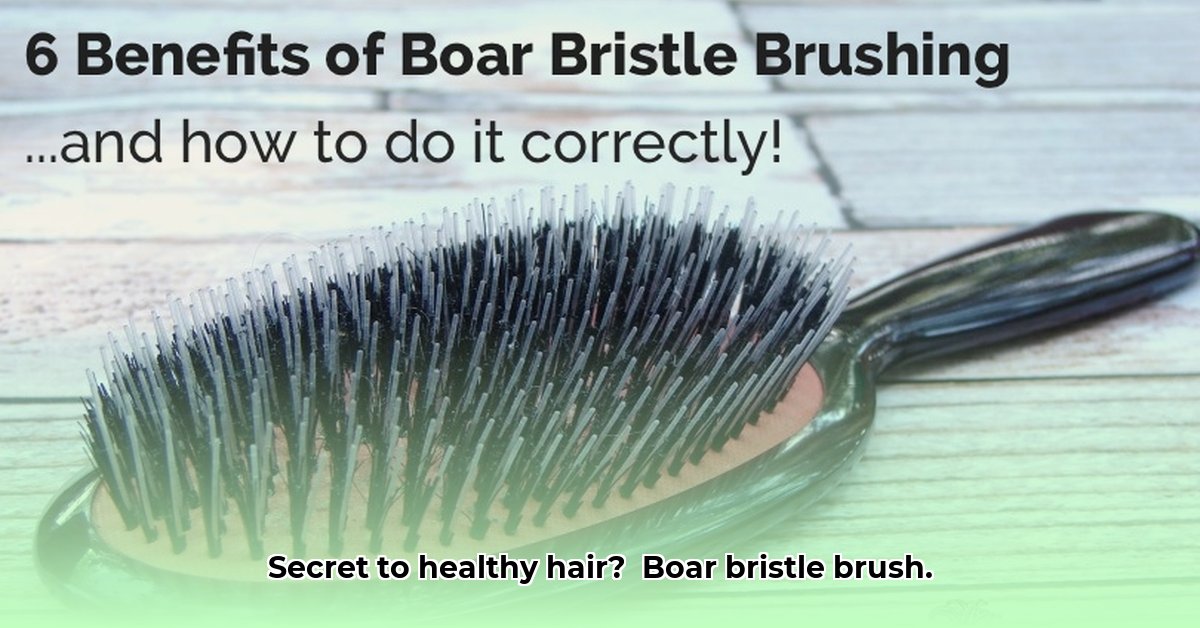
Understanding the Allure of Boar Bristle Brushes
Boar bristle brushes have gained popularity for their purported ability to enhance hair health and shine. But are these claims backed by science, or are they simply well-crafted marketing? This comprehensive review delves into the benefits, limitations, and proper usage of boar bristle brushes, offering a balanced perspective for informed decision-making. We'll explore the science behind the shine, address common concerns, and provide actionable steps for maximizing the benefits of this natural hair care tool.
The Science (and the Stories) Behind the Shine
Boar bristle brushes are lauded for their capacity to distribute sebum (the scalp's natural oil) along the hair shaft, acting as a natural conditioner. This even distribution contributes to smoother, softer, and less frizzy hair, resulting in a healthy-looking sheen. While anecdotal evidence abounds, larger-scale studies are needed to definitively quantify these benefits across diverse hair types. The current evidence primarily rests on user testimonials and observations rather than conclusive scientific data.
Gentle Treatment: Minimizing Hair Damage
Unlike some synthetic brushes, boar bristles are remarkably gentle on the hair. Their softness and flexibility minimize pulling, snagging, and breakage, making them ideal for individuals with fine, delicate, or easily damaged hair. This gentle approach helps preserve hair health and reduces potential damage caused by aggressive brushing.
Stimulating Scalp Circulation: A Potential Benefit
Brushing with a boar bristle brush may improve scalp circulation, potentially promoting healthier hair growth by enhancing nutrient delivery to the follicles. However, further research is needed to establish a direct causal link between boar bristle brushing and significant improvements in hair growth. While improved circulation is a plausible benefit, more robust studies are required to confirm its extent and impact.
Addressing Your Boar Bristle Brush Questions
Q: Are boar bristle brushes suitable for all hair types? A: While generally beneficial, the optimal brush density and bristle stiffness vary depending on hair type. Thicker, coarser hair may benefit from denser, firmer bristles, while finer hair requires a softer, less dense brush.
Q: How should I clean my boar bristle brush? A: Regular cleaning is vital. Remove loose hair with a comb, then gently wash the bristles with mild shampoo and lukewarm water. Rinse thoroughly and allow for complete air drying to prevent oil and product buildup, maintaining hygiene and brush efficacy.
Actionable Steps for Optimal Results
- Brushing Technique: Begin at the scalp and gently brush downwards towards the ends, avoiding harsh scrubbing. (Efficacy: Significantly minimizes breakage)
- Brushing Frequency: Aim for daily brushing, adjusting based on your hair's needs and texture. (Efficacy: Improves oil distribution and scalp stimulation)
- Brush Selection: Choose a boar bristle brush whose density and bristle stiffness match your hair type. (Efficacy: Maximizes benefit and minimizes damage)
Weighing the Pros and Cons
| Pros | Cons |
|---|---|
| Even sebum distribution for enhanced shine | Higher cost compared to some synthetic brushes |
| Potential scalp circulation improvement | Requires consistent cleaning |
| Minimizes hair breakage and split ends | Scientific evidence for some benefits is developing |
| Eco-friendly natural material | Effectiveness varies by hair type and brushing technique |
Choosing the Right Brush for Your Hair Type
The key to maximizing the benefits of a boar bristle brush lies in selecting the right one for your specific hair type. Pure boar bristle brushes, composed entirely of natural boar hair, excel at distributing oils, offering superior shine and conditioning. Mixed-bristle brushes, containing both boar and nylon bristles, can add volume and grip, which may be helpful for fine hair. However, for optimal sebum distribution, pure boar bristles remain the superior choice.
- Fine Hair: Choose a brush with softer, less densely packed bristles to prevent pulling or damage.
- Thick or Coarse Hair: Opt for a denser brush with firmer bristles for effective detangling and scalp stimulation.
- Curly Hair: Select a brush with wider bristle spacing to avoid disrupting curl patterns and minimize breakage.
Beyond bristle type, consider the handle material (wood is generally preferred for its durability and ergonomics) and the overall quality and construction of the brush. Reputable brands typically offer superior durability and performance.
Don't forget that proper brushing technique and regular cleaning are crucial for achieving the best results with your boar bristle brush. With the right approach, you can unlock the potential of this natural hair care tool and enjoy healthier, shinier, and more radiant hair.